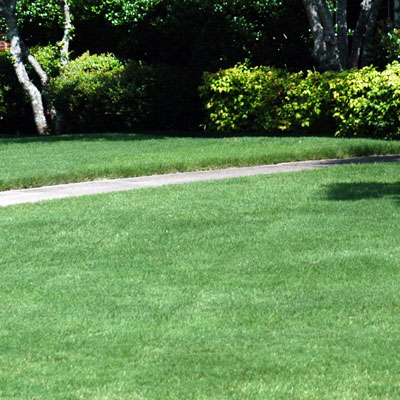Best Mowing Heights
I have a saying that I’ve used for many, many years when answering questions: “Tall grass becomes weak grass.” Mowing too tall causes turf to become thin. Blades stretch toward light (actually away from the dark).

Properly maintained St. Augustine is mowed fairly often and at the recommended height. Note diagonal pattern to keep grass from developing a “grain.”
As I give you the best mowing heights for each type of grass, let me remind you how low and dense little tufts of bermuda can be when they’re growing in cracks in sidewalks or highways. That’s not your goal in keeping your lawn healthy, but it proves the point that low, spreading grass is usually dense, better able to fend off the weeds.
Mow frequently. Try not to remove more than one-third of the blade length at each mowing. That may mean 5- or 6-day intervals, but if that’s the case, sobeit. Change your pattern of mowing periodically so the grass won’t develop a grain. If you’re using a mulching mower, leave the clippings in place. They will add to the nutrient level of the soil.
Best Mowing Heights
• Common bermudagrass: 1-1/4 to 1-1/2 inches. If you find that you are removing all the green growth each time that you mow, you could raise the mower one notch in June, but you must remember to drop it back down by that same notch in February.
• Hybrid bermudagrass: This will depend on which cultivar you’re growing. Some are kept at 1/4-inch, while others at 3/4- to 1-inch in height. Ask your turf vendor to be sure.
• St. Augustine: 2 to 2-1/2 inches. If shade is rather heavy and you’re not leaving much leaf surface after you mow, you may have to raise the mower one notch so you won’t be cutting off excessive blade length.
• Zoysias: These will vary with the type that you have. Most will be 2 to 3 inches. Be sure your mower mulches the clippings well. Zoysias are prone to thatch accumulations.
• Fescue: Mow these at 3 to 4 inches.
• Buffalograss: If being maintained as turf, mow it at 3-1/2 to 4 inches.
